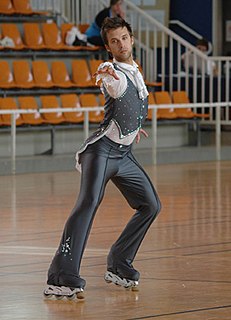
Mogema is a registered brand trademark owned by Sportsinline International BV (Est. 1999), a Dutch company that specialized in the design and production of inline- and ice speedskating products. Sportsinline International was founded by the parent company of the Mogema group [1] to design and produce speedskating products under the Mogema name. The company approached Design Engineer Diederik Hol to design a whole range of ice and inline speedskates that evolved under Hol's direction into Mogema's modern product line.

The Netherlands is a country located mainly in Northwestern Europe. The European portion of the Netherlands consists of twelve separate provinces that border Germany to the east, Belgium to the south, and the North Sea to the northwest, with maritime borders in the North Sea with Belgium, Germany and the United Kingdom. Together with three island territories in the Caribbean Sea—Bonaire, Sint Eustatius and Saba— it forms a constituent country of the Kingdom of the Netherlands. The official language is Dutch, but a secondary official language in the province of Friesland is West Frisian.

Inline speed skating is the roller sport of racing on inline skates, or as they may be mistakenly be called, rollerblades. The sport may also be called inline racing by participants. Although it primarily evolved from racing on traditional roller skates, the sport is similar enough to ice speed skating that many competitors are known to switch between inline and ice speed skating according to the season.
Diederik Hol is a Dutch Design Engineer, designer of the patented Dual Box inline skate frame and the Narrow Shape Cross-Section (NSX) ice blade, and founder/director of skate company CadoMotus Skating BV.
The 't Harde-based Mogema metalworking group in the Netherlands was the first to commercially produce an inline speedskating frame after two employees – both speedskaters – began using company technologies in their own time to produce a specialized speedskating frame in 1985. The frame they produced for themselves was quickly in demand among their friends and fellow speedskaters and production soon expanded. An agreement was reached soon after for Mogema metalworking to produce quantities of the frame for sale by the Stouwdam skate shop [2] in nearby Oldebroek.
't Harde is a village in the Dutch province of Gelderland. It is situated about 6 km southeast of Elburg, on the edge of the Veluwe forest. It has a train station with connections to Zwolle and Amersfoort. The village's population is approximately 6,685 people.

Metalworking is the process of working with metals to create individual parts, assemblies, or large-scale structures. The term covers a wide range of work from large ships and bridges to precise engine parts and delicate jewelry. It therefore includes a correspondingly wide range of skills, processes, and tools.

Oldebroek is a municipality and a town in the province of Gelderland. The municipality had a population of 23,435 in 2017.
The Mogema-branded frames were produced from extruded aluminium alloy and were soon sold around the world; becoming the must-have item for the world's elite roller speed skaters, who in 1992 had opened the World Speed Rollerskating Championships to inline skates for the first time. The frame design underwent a number of evolutions and eventually became the Mogema Diamond Series frame that for years was the most-prevalent inline speedskating frame in the world.

Extrusion is a process used to create objects of a fixed cross-sectional profile. A material is pushed through a die of the desired cross-section. The two main advantages of this process over other manufacturing processes are its ability to create very complex cross-sections, and to work materials that are brittle, because the material only encounters compressive and shear stresses. It also forms parts with an excellent surface finish.
Mogema was a technological innovator in speedskating sports products - the most commercially successful being the Dual Box inline skating frames, a patented design developed by Diederik Hol while working at Mogema.
Dual Box or DualBox is the trademark name for the patented tubular sidewall inline skating frame, which employs the mechanical properties of the tubular to optimize the performance of a frame or chassis that secures the wheels on an inline skate.
Late in 2006, lead designer Diederik Hol left Mogema to start his own skating company CadoMotus. [3] Although some inaccurate reports indicated Mogema itself was changing its name, [4] the owners of Sportsinline International made the decision to dissolve the company at the end of that year. Hol established his own brand in 2007, together with Henk Schra (then owner of Stouwdam skate shop), producing a CadoMotus-branded frame using the Dual Box technology - the patent for which he had licensed from Sportsinline's owners.











